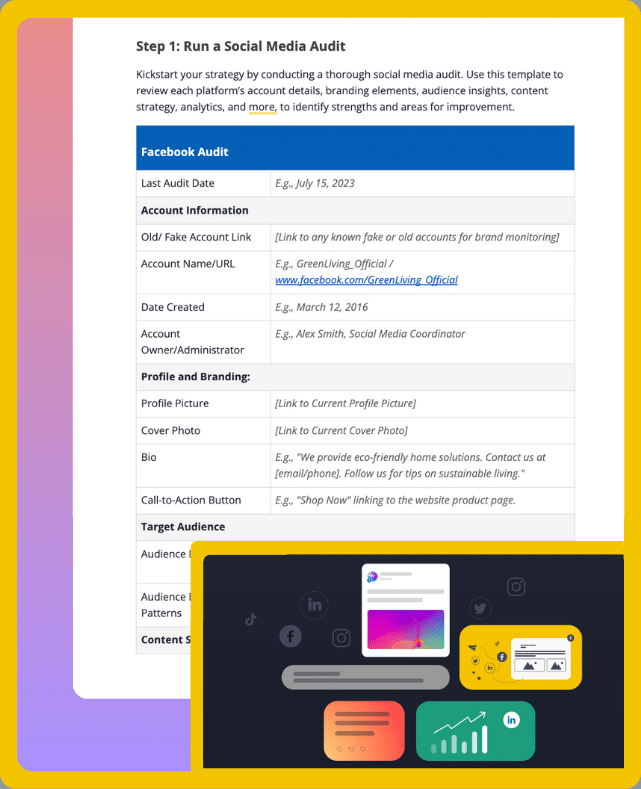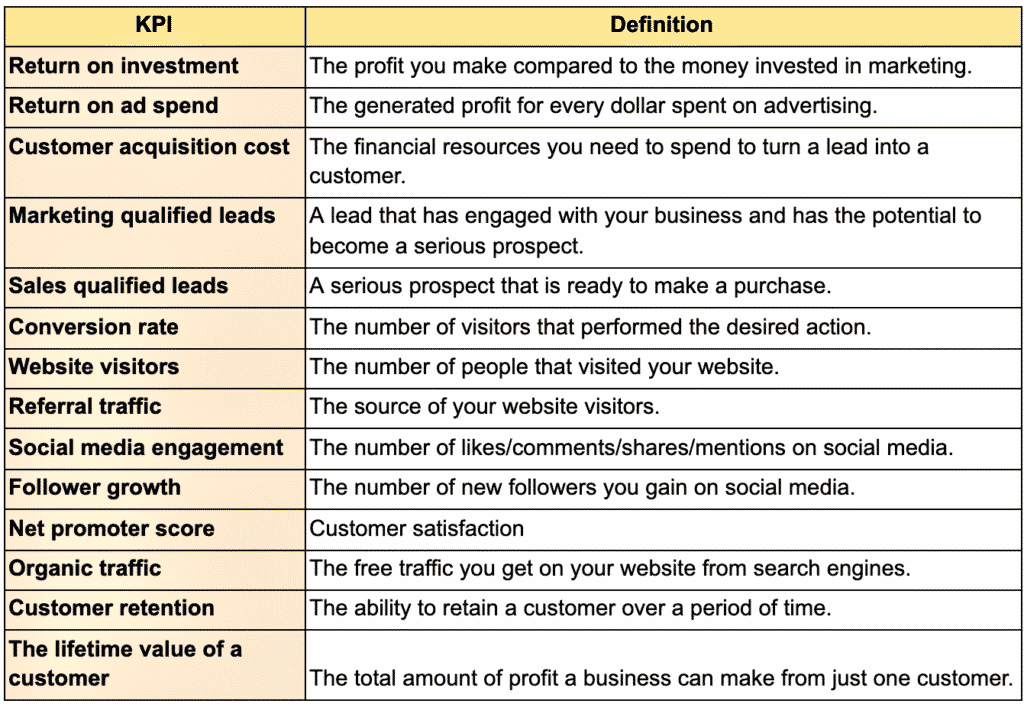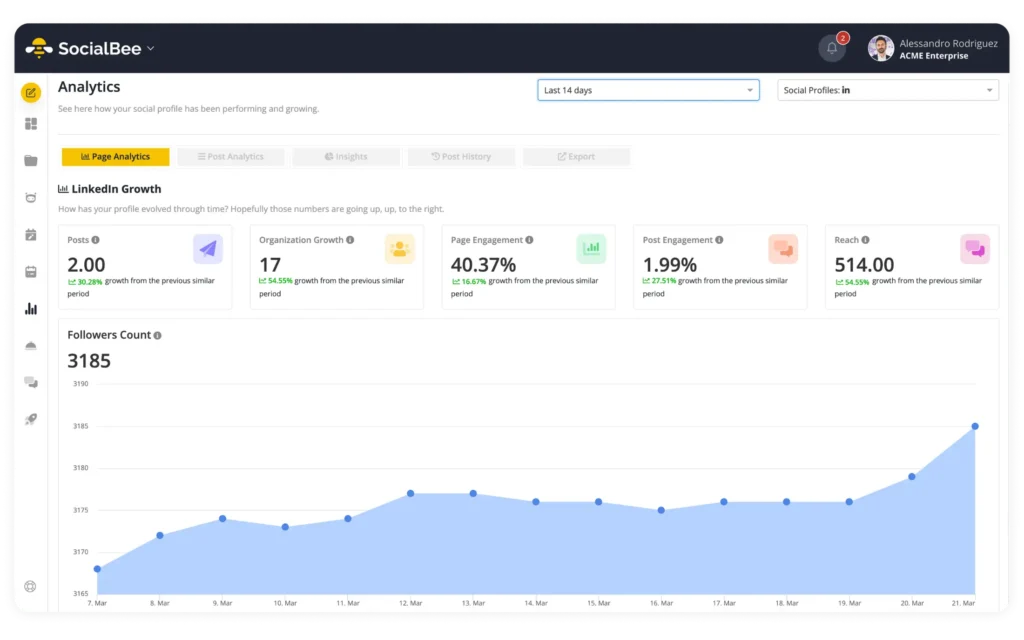What came first: the marketing objective or the marketing strategy? That is the question.
To us, the answer is obvious: marketing objectives come before the marketing strategy.
Why? Because you can’t achieve something that you don’t define. Therefore, to run a successful marketing strategy, you need effective objectives that offer direction and clarity to help you and your team navigate your way to success.
Let’s take a closer look at what a marketing objective is, why and how to define it, as well as a few examples to get you started before setting your own.
We’re SocialBee LABS SRL, part of WebPros. We use the information you provide to share relevant content and product updates, as outlined in our Privacy Policy. You can opt out anytime.

Short summary
- Marketing objectives define the outcomes a marketing team aims to achieve, guiding strategy and measuring success.
- A good marketing strategy helps identify the right audience, create brand awareness, engage customers, and drive sales.
- Effective marketing objectives should align with business goals and be based on thorough market research.
- SMART criteria (specific, measurable, attainable, relevant, time-based) ensure you set actionable marketing objectives that you can track.
- Marketing KPIs like ROI, conversion rates, customer acquisition costs, and social media engagement help monitor progress.
- Objective-setting provides focus, accountability, and a clear path to success, helping teams allocate resources effectively.
- Marketing objectives focus on specific campaigns and short-term results, while business objectives drive overall company growth and long-term success.
- To connect marketing goals to business goals, ensure every marketing strategy directly supports business growth and profitability.
- To set strong marketing objectives, prioritize your biggest growth opportunities, keep objectives focused and actionable, and balance short-term wins with long-term growth.
- Common marketing objectives include increasing sales, boosting brand awareness, growing market share, improving customer retention, generating leads, and optimizing brand positioning.
What are marketing objectives?
Marketing objectives are the outcomes that the marketing team plans to achieve in the future. As such, they outline both a clear direction for the marketing strategy and the specific actions that need to be taken to reach the desired results.
When marketing objectives are well-defined, they make it easier to determine whether the marketing strategy is efficient or it needs adjustments. It gives you a benchmark against which you can evaluate performance.
What is the purpose of a marketing strategy?
Brands use marketing strategies to:
- Identify and target the right audience/market.
- Create an effective value proposition that resonates with the target customer.
- Develop a clear positioning statement.
- Create brand awareness and recognition.
- Boost brand engagement through various channels such as social media, SEO, email campaigns, etc.
- Generate leads and build relationships with prospects.
- Increase sales and revenue.
All these goals must be aligned with the overall mission of your business in order to ensure success.
And remember, a good marketing strategy should be based on a thorough market research in order to devise an effective plan that will deliver long-term growth.
What qualities should your marketing objectives have?
Great marketing objectives should follow the SMART framework:
1. Specific
Focus on what you want to achieve and how you want to achieve it.
2. Measurable
Identify KPIs that will help you measure your progress.
3. Attainable
Aim for a target that is ambitious but realistic.
4. Relevant
Make sure your objectives align with your business needs.
5. Time-based
Set a deadline for your objectives to help you stay focused on achieving them in a limited time frame.
| SMART objective example: “We will grow our Facebook audience by gaining 100 followers every month for the next 3 months.” |
What are marketing KPIs?
Marketing KPIs (or Key Performance Indicators) are values that help you monitor your progress and find out if you are on the right track for achieving your smart marketing objectives.
To be more specific, let’s go back to our previous SMART objective example: “We will grow our Facebook audience by gaining 100 followers every month for the next 3 months.”
The KPI from this SMART objective is the number of new followers approximated (follower growth).
Here are the main marketing KPIs you should use to evaluate the progress you made in achieving your marketing objectives:
- Return on investment – The profit you make compared to the money invested in marketing.
- Return on ad spend – The generated profit for money spent on advertising.
- Customer acquisition cost – The financial resources you need to spend to turn a lead into a customer.
- Marketing qualified leads – Leads that have engaged with your business and have the potential to become prospective customers.
- Sales qualified leads – A serious prospect that is ready to make a purchase.
- Conversion rate – The number of visitors that performed the desired action.
- Website visitors – The number of people that visited your website.
Note: remember that website visitors can return to your website for a second, third visit. Hence, it’s important you split your audience into “New Visitors” and “Returning Visitors” in Google Analytics.
- Referral traffic – The source of your website visitors.
- Social media engagement – The number of likes/comments/shares/mentions on social media.
- Follower growth – The number of new followers you gain on social media.
- Net promoter score – Customer satisfaction or customer loyalty
- Organic traffic – The free traffic you get on your website from search engines.
- Customer retention rate – The ability to retain a new customer over a period of time.
- Number of new customers: The number of new customers acquired over a certain period;
- The lifetime value of a customer – The total amount of profit a business can make from just one customer.
To monitor the effectiveness of your marketing strategy, you need to pay attention to all your promotional channels, including your digital advertising campaigns.
As you see, there are many different ways to measure the effectiveness of your marketing strategy, whether you’re looking for B2C or B2B marketing KPIs. Still, the most important part is to clearly define your marketing objectives and find a way to measure and track them continuously.
Monitoring your own objectives for social media growth is easier when you have everything you need under one dashboard.
With SocialBee, you can create, schedule, and post your social media content on your favorite platforms from one place. You can also evaluate your performance constantly and gather the data you need to adjust your content strategy for success.
SocialBee’s analytics dashboard allows you to monitor the performance of all your social media accounts from one place.
Why is objective-setting important in marketing?
Objective-setting is important in marketing because it helps you focus on the desired outcomes while providing a clear path for achieving those results.
Setting objectives can also help marketers measure progress, track performance, stay motivated, and identify areas for improvement. Objectives can serve as a guide to direct resources in the most effective way and make sure that time, energy, and money are spent efficiently.
Objective-setting also provides a sense of accountability for the marketing department and encourages a smooth collaboration among clients, partners, and marketing teams.
What is the difference between marketing objectives and business objectives?
Marketing objectives are the specific goals a company sets to achieve through its marketing efforts. These objectives can include increasing brand awareness, generating more leads, and converting prospects into customers.
They are typically focused on short-term results and often involve tactics such as creating campaigns, setting up promotions and events, or launching new products.
Business objectives, on the other hand, are the objectives that a company sets to achieve its overall business strategy. These objectives can include expanding into new markets, increasing brand loyalty, and improving operational efficiency.
Business objectives tend to be broader in scope than marketing objectives, as they often involve creating relationships with partners, investing in technology or infrastructure, and introducing new products or services.
Business objectives also serve as the foundation of a company’s marketing strategy, by providing the target market, budget, and resources needed to achieve marketing objectives.
How do you connect a marketing goal to a business goal?
The key to connecting marketing objectives to business objectives is understanding how each tactic and strategy will support the overall company growth and profitability.
First, ask yourself: How will this marketing action help me reach my ultimate business objectives? Then, look for ways to measure the efficiency of each marketing activity and track its impact on your business’s bottom line.
If there are activities that don’t seem to directly support your business objectives, explore more marketing strategies until you find the perfect solution for your company.
How do you set good marketing objectives?
Here are three best practices for setting good marketing objectives:
- Prioritize based on your biggest growth opportunity
- Keep it focused and actionable
- Balance short-term wins with long-term growth
1. Prioritize based on your biggest growth opportunity
Not all marketing objectives carry the same weight. While boosting conversions sounds great, it won’t move the needle if brand awareness is your real bottleneck.
Take a step back and assess where the biggest opportunity lies, whether it’s attracting more leads, improving engagement, or retaining existing customers. Let data from your CRM, website analytics, and past campaigns guide your decision.
2. Keep it focused and actionable
A long list of objectives can spread your resources too thin. Instead, pick one or two key objectives that align with your broader business goals. The most effective marketing strategies are built around focused priorities. Too many competing goals can dilute impact.
Whether you’re optimizing your funnel or increasing brand recognition, make sure your objectives are clear, actionable, and aligned with your capacity.
3. Balance short-term wins with long-term growth
Some marketing objectives will deliver quick results, while others take time to build momentum. A well-rounded strategy balances both.
For example, running ads may generate immediate traffic, but investing in SEO and brand-building efforts ensures sustainable growth. When setting your objectives, consider how they contribute to both immediate success and long-term brand positioning.
11 effective marketing objective examples
Now that we know how to define marketing objectives and what makes them valuable to a marketing strategy, it’s time to explore the topic from a more practical angle.
Here are 11 examples of marketing objectives that you should use for your business:
- Increase sales
- Generate brand awareness
- Increase market share
- Boost customer retention rates
- Generate new leads
- Gain more website traffic
- Increase profits
- Develop a social media presence
- Grow your email list
- Optimize brand positioning
- Increase customer lifetime value
1. Increase sales
If you are a business that sells products or services, your main focus will be to make more profit by selling more of what you have to offer.
To do so, you have several marketing initiatives at your disposal that help you attract new customers and increase revenue the line (e.g. running digital ads and banner ads, increasing website visitors, starting a limited promotion, distributing interactive digital catalogs).
It all depends on how much you want to achieve in a limited timeframe with your current sales process and the means available to you. Don’t forget to always measure customer acquisition with each new marketing campaign or process you launch.
| Example of an increasing sales objective: “Boost sales by 10% in the next three months by increasing website traffic with the help of weekly promotional social posts.” |
2. Generate brand awareness
Are you looking to increase your visibility as a business? In this case, you might want to grow your brand awareness. This will help you establish your business as a trustworthy entity.
By generating brand awareness you get your target audience interested in your business. This is the first step that allows you to turn leads into paying customers.
Having your target audience recognize, remember, and associate your business with key values means that you become their top-of-mind when they are considering making a purchase.
| Example of a brand awareness objective: “Increase brand awareness by sharing our blog posts once a week for the following six months on Facebook, LinkedIn, and Google My Business.” |
3. Increase market share
Market share represents the percentage of a market dominated by a business. More exactly, the market share of a business is the number of sales made in a limited time frame compared to the total sales in the industry.
For example, if there are 100 chairs sold every week, and a business sells 40 chairs a week, it means that the business in question has a market share of 40%.
Market share is important for any business because:
- It develops a cost advantage against the competition.
- It increases sales and profitability.
- It expands the customer base and helps you find a new market for your products and services.
- It helps with brand building.
| Example of a market share objective: “Obtain a 10% increase in the market share for product X by the end of the year by lowering its price by 10%.” |
4. Boost customer retention rates
Focusing on customer loyalty is as important as gaining more customers. Moreover, experts say that it’s even more cost-effective to keep existing customers than it is to gain new ones. A business can pay up to 25% more to gain a new customer than to maintain one.
Having a loyal customer base offers stability to a business by providing a consistent revenue stream.
To keep your customers interested in what you have to offer, you can invest in the quality of your customer service, improve your community management on social media, develop a loyalty program, and more.
If you want to keep your Instagram community happy and engaged, SocialBee has the perfect service for you that allows you to interact with your customers without the work that comes with it.
| Example of customer retention objective: “Increase customer retention rates by 30% in a year by developing a loyalty program.” |
5. Generate new leads
Attracting new leads increases your chances of gaining potential customers and ultimately selling more of your products and services. Also, it keeps your business relevant and profitable.
Lead generation is a practice that draws new prospects to a brand and maintains their interest through lead nurturing.
A great way of generating new leads for your business is by creating lead magnets (offers such as free guides, templates, and free consultations customers can benefit from by revealing their contact information) and posting them on your blog and social media accounts. This will fill your client relationship management (CRM) system with qualified prospects.
With the help of marketing communication strategies, interactive content, and practices such as influencer collaborations, the leads start to trust and connect with a brand and ideally become paying customers.
| Example of a lead generation objective: “Generate 50% more leads in the following six months by collaborating with five niche Instagram influencers.” |
6. Gain more website traffic
Your website is a valuable part of your business and digital marketing efforts. It is part of your image, it communicates your brand identity, and most importantly is where you convert your leads into customers.
That is why businesses tend to focus on getting as much traffic to their website as possible through both paid initiatives and organic strategies.
| Example of website traffic objective: “Increase website traffic by 15% in the next two months through link building and social media posts.” |
7. Increase profits
All marketing efforts focus on generating profit. Sometimes, smart financial decisions include both reducing costs and investing resources in profitable marketing tools and practices (planning an advertising campaign, for example).
So, make sure you set marketing and advertising objectives that will help you generate more profit while also keeping your budget in mind.
Ideally, businesses should find a balance between paid and organic strategies and constantly monitor what works best for their needs. To do so, marketers can regularly calculate the return on investment (ROI) for the tools and services they use in their strategy, as well as the customer acquisition cost (CAC).
| Example of an advertising objective: “Invest 20% in paid ads for the following year and run advertisements on Facebook and Instagram once every two months.” |
8. Develop a social media presence
Social media has become the perfect environment for business growth. With more and more users turning to social media to research businesses before making a purchase, there is no doubt about the impact it has on business growth, brand awareness metrics, and brand authority.
Find the social media networks where your target audience is most active and build a presence there. This will increase your visibility and increase brand loyalty. It will also give you a great medium for both organic and paid advertising.
Don’t forget to use social media management tools like SocialBee to create, schedule, and post your content. That way, you will stay consistent and improve your reach and engagement rate.
| Example of a social media marketing objective: “Post three times a week on Facebook, Instagram, and LinkedIn for the next 12 months to gain 100 new followers each month.” |
9. Grow your email list
Email outreach is a powerful marketing channel. With more than four billion users and an ROI of $42 for every dollar spent, it’s safe to say that it’s a great investment.
The best advantage of email marketing is that you can easily measure if it’s working or not because you know exactly who received your email and the actions they took once they saw it.
To create great email marketing campaigns, you have to:
- Have a significant email list.
- Invest in an email service provider.
- Use powerful subject lines.
- Create an engaging copy.
You need reliable software to succeed in email marketing. Thankfully, there are many free email marketing software available. You can take them for a test drive and if you like the features, you can incorporate them into your marketing toolset.
| Example of email marketing objective: “Double our email list within the next three months by creating a lead magnet and promoting it on our website.” |
10. Optimize brand positioning
Last but not least on our list of marketing objective examples is brand positioning.
Positioning your brand is extremely important, as it controls the way your audience views and perceives your business. Also, it helps businesses stand out from the crowd and differentiates their products and services from the competition.
Setting goals and focusing on brand positioning should be a priority for your marketing team, as it helps you manage your brand reputation and image.
| Example of brand positioning objective: “Create a strong brand positioning statement and communication strategy by the end of the month so that our employees understand the differentiating factors of our business.” |
11. Increase customer lifetime value
In order to get more value from your customers and increase AOV (average order value) you have two options: cross-sell and upsell.
Put in simple terms, you’re encouraging your customers to add more products/ services to their cart, whether it’s for a complementary service you have (cross-sell) or for a higher tier of the same service (up-sell).
Before asking your customers to do so, make sure they need those services and that they might be willing to expand their budget in this direction. One way to make sure your customers stay open to such purchases is to ensure an excellent post-sale experience.
| Example of increasing customer lifetime value objective: “Offer a customer loyalty program with rewards and points that can be used at your customers’ second purchase.” |
Frequently asked questions
The 4 Ps of Marketing are the key elements that define a successful marketing strategy:
- Product – What you’re selling, including its features, design, quality, and how it meets customer needs.
- Price – How much you charge for the product, considering factors like competition, perceived value, and pricing strategies.
- Place – Where and how your product is sold, including distribution channels like online stores, retail locations, or direct sales.
- Promotion – The marketing tactics used to promote the product, such as advertising, social media, content marketing, and public relations.
These elements work together to attract and retain customers while driving business growth.
Marketing objectives should be reviewed at least quarterly to ensure they align with current market trends, business goals, and performance data. Regular adjustments help optimize strategies based on real-time insights and changing consumer behavior.
Common mistakes include setting vague goals, failing to track key performance indicators, prioritizing too many objectives at once, and not aligning them with overall business strategy. Clear, measurable, and focused objectives drive better results.
Are you ready to outline your own marketing objectives?
Now that you know all about setting smart business goals through the power of 11 strong measurable marketing objective examples, you are all set to go.
Make sure you start the path to a successful marketing strategy with clear and quantifiable goals. Define what you want to achieve, and you will have a way to measure progress and maintain it by adjusting your marketing plan as you go.
You can get started on building your social media presence right away with the help of SocialBee. Start your 14-day free trial today and build a content strategy that will grow your online followers and engagement with ease.












